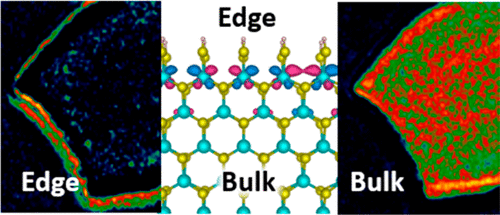当前位置:
X-MOL 学术
›
ACS Cent. Sci.
›
论文详情
Our official English website, www.x-mol.net, welcomes your feedback! (Note: you will need to create a separate account there.)
Mapping Catalytically Relevant Edge Electronic States of MoS2
ACS Central Science ( IF 18.2 ) Pub Date : 2018-04-03 00:00:00 , DOI: 10.1021/acscentsci.8b00042 Abhishek Parija 1 , Yun-Hyuk Choi 1 , Zhuotong Liu 1 , Justin L. Andrews 1 , Luis R. De Jesus 1 , Sirine C. Fakra , Mohammed Al-Hashimi 2 , James D. Batteas 1 , David Prendergast , Sarbajit Banerjee 1
ACS Central Science ( IF 18.2 ) Pub Date : 2018-04-03 00:00:00 , DOI: 10.1021/acscentsci.8b00042 Abhishek Parija 1 , Yun-Hyuk Choi 1 , Zhuotong Liu 1 , Justin L. Andrews 1 , Luis R. De Jesus 1 , Sirine C. Fakra , Mohammed Al-Hashimi 2 , James D. Batteas 1 , David Prendergast , Sarbajit Banerjee 1
Affiliation

|
Molybdenum disulfide (MoS2) is a semiconducting transition metal dichalcogenide that is known to be a catalyst for both the hydrogen evolution reaction (HER) as well as for hydro-desulfurization (HDS) of sulfur-rich hydrocarbon fuels. Specifically, the edges of MoS2 nanostructures are known to be far more catalytically active as compared to unmodified basal planes. However, in the absence of the precise details of the geometric and electronic structure of the active catalytic sites, a rational means of modulating edge reactivity remain to be developed. Here we demonstrate using first-principles calculations, X-ray absorption spectroscopy, as well as scanning transmission X-ray microscopy (STXM) imaging that edge corrugations yield distinctive spectroscopic signatures corresponding to increased localization of hybrid Mo 4d states. Independent spectroscopic signatures of such edge states are identified at both the S L2,3 and S K-edges with distinctive spatial localization of such states observed in S L2,3-edge STXM imaging. The presence of such low-energy hybrid states at the edge of the conduction band is seen to correlate with substantially enhanced electrocatalytic activity in terms of a lower Tafel slope and higher exchange current density. These results elucidate the nature of the edge electronic structure and provide a clear framework for its rational manipulation to enhance catalytic activity.
中文翻译:

映射MoS 2的催化相关边缘电子状态
二硫化钼(MoS 2)是一种半导体过渡金属二硫化氢,已知是富氢烃燃料的氢气释放反应(HER)和加氢脱硫(HDS)的催化剂。具体来说,MoS 2的边缘已知与未修饰的基础平面相比,纳米结构具有更高的催化活性。然而,在缺少活性催化位点的几何和电子结构的精确细节的情况下,仍然需要开发一种调节边缘反应性的合理手段。在这里,我们展示了使用第一性原理计算,X射线吸收光谱以及扫描透射X射线显微镜(STXM)成像,表明边缘皱纹产生了独特的光谱特征,这些特征对应于混合Mo 4d态的增加的局部化。在SL 2,3和S K边缘都可以识别出这种边缘状态的独立光谱特征,并在SL 2,3中观察到了这种状态的独特空间定位边缘STXM成像。在较低的Tafel斜率和较高的交换电流密度方面,可以看出在导带的边缘处存在这种低能量的杂化态与实质上增强的电催化活性相关。这些结果阐明了边缘电子结构的性质,并为其合理操纵以增强催化活性提供了清晰的框架。
更新日期:2018-04-03
中文翻译:

映射MoS 2的催化相关边缘电子状态
二硫化钼(MoS 2)是一种半导体过渡金属二硫化氢,已知是富氢烃燃料的氢气释放反应(HER)和加氢脱硫(HDS)的催化剂。具体来说,MoS 2的边缘已知与未修饰的基础平面相比,纳米结构具有更高的催化活性。然而,在缺少活性催化位点的几何和电子结构的精确细节的情况下,仍然需要开发一种调节边缘反应性的合理手段。在这里,我们展示了使用第一性原理计算,X射线吸收光谱以及扫描透射X射线显微镜(STXM)成像,表明边缘皱纹产生了独特的光谱特征,这些特征对应于混合Mo 4d态的增加的局部化。在SL 2,3和S K边缘都可以识别出这种边缘状态的独立光谱特征,并在SL 2,3中观察到了这种状态的独特空间定位边缘STXM成像。在较低的Tafel斜率和较高的交换电流密度方面,可以看出在导带的边缘处存在这种低能量的杂化态与实质上增强的电催化活性相关。这些结果阐明了边缘电子结构的性质,并为其合理操纵以增强催化活性提供了清晰的框架。



























 京公网安备 11010802027423号
京公网安备 11010802027423号